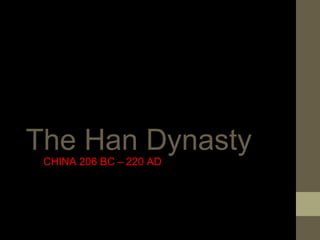
The Han Dynasty - Fred Hill 5T
- 1. The Han Dynasty CHINA 206 BC – 220 AD
- 2. Timeline • Credit to bashapedia.pbworks.com • 206 B.C- Founding of Han Dynasty • 206-202 B.C- Civil War (Liu Bang vs. Xiang Yu) • 202 B.C- Han takes control: Liu Bang becomes Gao-di , • Establishment of ten “feudal kingdoms in eastern China • 201 B.C- Unsuccessful Xiong-nu war, Establishment of appeasement policies in dealings with non-Chinese people • 195 B.C- Nine out of ten kingdoms have been brought under Liu control through conquer, Death of Liu Bang, beginning influence of his wife, Empress Lü • 191 B.C- Lifting of book ban • 179-157 B.C- Reign of Wen-di • Reinstatement of “provoke and conquer” policies towards feudal kingdoms • Height of Huang-Lao influence • Gradual imperial patronage of Confucian Scholarship • 154 B.C- Unsuccessful rebellion of feudal kingdoms permanently breaks their power • 140-87 B.C- Reign of Wu-di • 140-135 B.C- Huang-Lao court influence persists through power of Dowager Empress Dou (widow of Wen-di) • 140 B.C- Wu-di calls for talent search and policy advice -- Dong Zhong-shu responds • 135 B.C- Wu-di implements recommendations of Dong Zhong-shu • Establishment of Confucianism as a state ideology • Empress Dou dies • 98 B.C- Sima Qian's defense of General Li Ling's conduct leads to his castration • 91 B.C- Great witchcraft crisis closes Wu-di's reign in a shambles • 78 B.C- The Sui Meng incident • 220 C.E- A growing population, increased wealth, resultant financial difficulties, and ever more complex political institutions along with massive corruption leads to the fall of the Han Dynasty.
- 3. How it Started Liu Bang started the Han Dynast in 202 BC, as a military general. It started when Shi Huandis, of the Qin Dynasty, died and his son who was a worse ruler than his father, took over. A civil war broke out and Liu Bang was on the winning side! Thus the Qin Dynasty crumbled and the Han Dynasty began. Liu Bang
- 5. The People • 90% of people lived in the country. Cities were laid out with roads and alleys. Each city was surrounded by a wall made of stone and earth. The ancient Han cities were the centre of government and where most things happened, lots of arts and entertainment were around. • Many poor people lives together and near each other. Young men among the poor often joined gangs on the streets of the cities. • The rich tried to reproduce the imperial palaces for themselves, showing off their wealth to others. They had very large dwellings and had sculptures and paintings. Their children studied many subjects, many
- 6. Power and Jobs • Liu Bang was the first emperor of China. • Many young scholars and academics worked for the government rather than being expelled. • He put these academics in high places to be judges and governors given that they were clever and fair • He would not let women govern or judge no matter their intelligence
- 7. Arts and Sciences • Although a lot was lost during the book burnings of the Qin Dynasty, the Han people tried very hard to replace the literature that was lost during Qin times, especially the works of Confucius. • They worked very hard to create new arts and literature. Beautiful paintings appeared on palace walls, craftsmen made jewellery ornaments carvings and ornaments. Iron was used more to produce things, Glazed pottery in 'cave art' style was made depicting bears and hunters etc. They also worked to advance further their medicines.
- 8. Public Schools In 100CE Emperor Wudi agreed with Confucius that it was a good idea to have a public school in each province. (For boys only) These schools were set up, honouring the works of Confucius to the highest, helped with Confucian teachers In the capital a 'Grand School' was set up in the capital for 50 students, although in only 100 years this grew to 30 000!
- 9. Summary Although there were many Although there were many rebellions and civil wars during rebellions and civil wars during and before the Han dynasty, arts, and before the Han dynasty, arts, sciences, culture and schooling all sciences, culture and schooling all thrived in the era. thrived in the era. The Han Dynasty ultimately The Han Dynasty ultimately All in all, the Han Dynasty was not ended due to population growth ended due to population growth All in all, the Han Dynasty was not too different from the Qin dynasty and corruption in the government, and corruption in the government, too different from the Qin dynasty that Liu Bang took over. but there were always skirmishes but there were always skirmishes that Liu Bang took over. and crises throughout. and crises throughout.